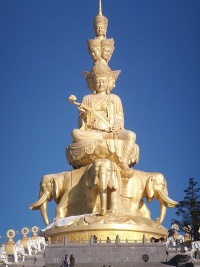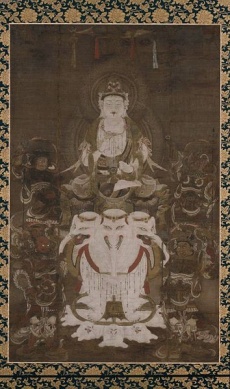Samantabhadra
Samantabhadra (Sanskrit: समन्तभद्र; literally Universal Worthy), is a bodhisattva in Mahayana Buddhism associated with Buddhist practice and meditation. Together with Shakyamuni Buddha and fellow bodhisattva Manjusri he forms the Shakyamuni trinity in Buddhism. He is the patron of the Lotus Sūtra and, according to the Avataṃsaka Sūtra, made the ten great vows which are the basis of a bodhisattva. In China, Samantabhadra is associated with action, whereas the bodhisattva Mañjuśrī is associated with wisdom. In Japan this bodhisattva is often venerated by the Tendai and Shingon sects, and as the protector of the Lotus Sūtra by the Nichiren sect.
In the Nyingma school of Tibetan Buddhist Vajrayana, Samantabhadra is considered a primordial Buddha in indivisible yab-yum union with his consort Samantabhadri.
Origins
In the Lotus Sūtra, Samantabhadra is described at length in the epilogue, called the Samantabhadra Meditation Sutra (Chinese: 觀普賢菩薩行法經; pinyin: Guān Pǔxián Púsà Xíngfǎ Jīng), with special detail given to visualization of the bodhisattva, and the virtues of devotion to him.
Samantabhadra is also a key figure in the Āvataṃsaka-sūtra, particularly the last chapter, the Gaṇḍavyūha-sūtra. In the climax of the Gaṇḍavyūha-sūtra, the student Sudhana meets Samantabhadra Bodhisattva, who teaches him that wisdom only exists for the sake of putting it into practice; that it is only good insofar as it benefits all living beings.
In the Āvataṃsaka-sūtra, the Buddha states that Samantabhadra Bodhisattva made ten great vows in his path to full Buddhahood:
- To pay homage and respect to all Buddhas.
- To praise all the Buddhas.
- To make abundant offerings. (i.e. give generously)
- To repent misdeeds and evil karmas.
- To rejoice in others' merits and virtues.
- To request the Buddhas to continue teaching.
- To request the Buddhas to remain in the world.
- To follow the teachings of the Buddhas at all times.
- To accommodate and benefit all living beings.
- To transfer all merits and virtues to benefit all beings.
The ten vows have become a common practice in East Asian Buddhism, particularly the tenth vow, with many Buddhists traditionally dedicating their merit and good works to all beings during Buddhist liturgies.
Iconography
In Mahayana Buddhism
Unlike his more popular counterpart Manjusri, Samantabhadra is only rarely depicted alone and is usually found in a trinity on the right side of Shakyamuni, mounted on a white elephant. In those traditions that accept the Avatamsaka Sutra as its root instruction, Samantabhadra and Manjusri flank Vairocana Buddha, the central Buddha of this particular sutra.
Known as Pǔxián in Chinese, he is sometimes shown in Chinese art with feminine characteristics, riding an elephant with six pairs of tusks while carrying a lotus leaf 'parasol' (Sanskrit: chhatra), bearing similar dress and features to some feminine depictions of Kuan Yin. It is in this guise that Samantabhadra is revered as the patron bodhisattva of the monasteries associated with Mount Emei in western China. Some believe that the white elephant mount of Samantabhadra was the same elephant that appeared to Queen Maya, the mother of the Buddha, to herald his birth.
Among those esoteric traditions that treat Samantabhadra as the 'Primordial' (Sanskrit: Dharmakaya) Buddha, he is often represented 'naked' ("sky clad"; Sanskrit: digambara), with a dark blue body, in union with his consort Samantabhadri.
In Esoteric Buddhism
In the Tibetan Buddhist tradition, particularly the Nyingma school, Samantabhadra is considered the most primordial Buddha, akin in status to Vajradhara for the Sarma traditions. Samantabhadra appears in the Vajrayana tantric text the Kunjed Gyalpo Tantra, as the Primordial Buddha, the 'embodiment' (Sanskrit: kaya) or 'field' (Sanskrit: kṣetra) of 'timeless awareness, gnosis' (Sanskrit: jñāna) awakened since before the very beginning. Therefore in Tibetan Buddhism the Nyingma, or 'Old Translation' school, the Sakya and the Bön schools view Samantabhadra as the Primordial Buddha. In the Nyingma school of Tibetan Buddhist Vajrayana, Samantabhadra is considered a primordial Buddha in indivisible yab-yum union with his consort Samantabhadri. However, the Kagyu and Gelug schools use Vajradhara to represent the Primordial Buddha.
Dzongsar Khyentse Rinpoche following the Nyingmapa Dzogchen tradition qualifies the nature and essence of Samantabhadra, the Primordial Buddha, as the origin-less wellspring of the timeless and unbounded Atiyoga teachings, and honours the converse view entertained by some interested parties which hold that the Dzogchen teachings originated with either the Bonpo tradition or the Chinese monk Moheyan (1990: p.xxi):
- Samantabhadra is not subject to limits of time, place, or physical conditions. Samantabhadra is not a colored being with two eyes, etc. Samantabhadra is the unity of awareness and emptiness, the unity of appearances and emptiness, the nature of mind, natural clarity with unceasing compassion - that is Samantabhadra from the very beginning.
Samantabhadra is usually presented with colour black. The Dorje Zahorma hat, that is a special form of the Dorje Zahorma hat which is particular to Chatral Rinpoches tradition, is emblazoned with an image of Samantabhadra.
'The Mirror of the Mind of Samantabhadra' (Tibetan: ཀུན་ཏུ་བཟང་པོ་ཐུགས་ཀྱི་མེ་ལོང, Wylie: kun tu bzang po thugs kyi me long) is one of the Seventeen Tantras of Dzogchen Upadesha.
In Sri Lanka
- See also: Saman
Sri Lankan people venerates Samantabhadra Bodhisatva as Saman (also called Sumana, Samantha, Sumana Saman, Sinhalese: සුමන සමන් දෙවි). The name Saman means "the rising morning sun". God Saman is considered one of the guardian deities of the island and Buddhism. His main shrine is located in Ratnapura, where there is an annual festival held in his honor.


